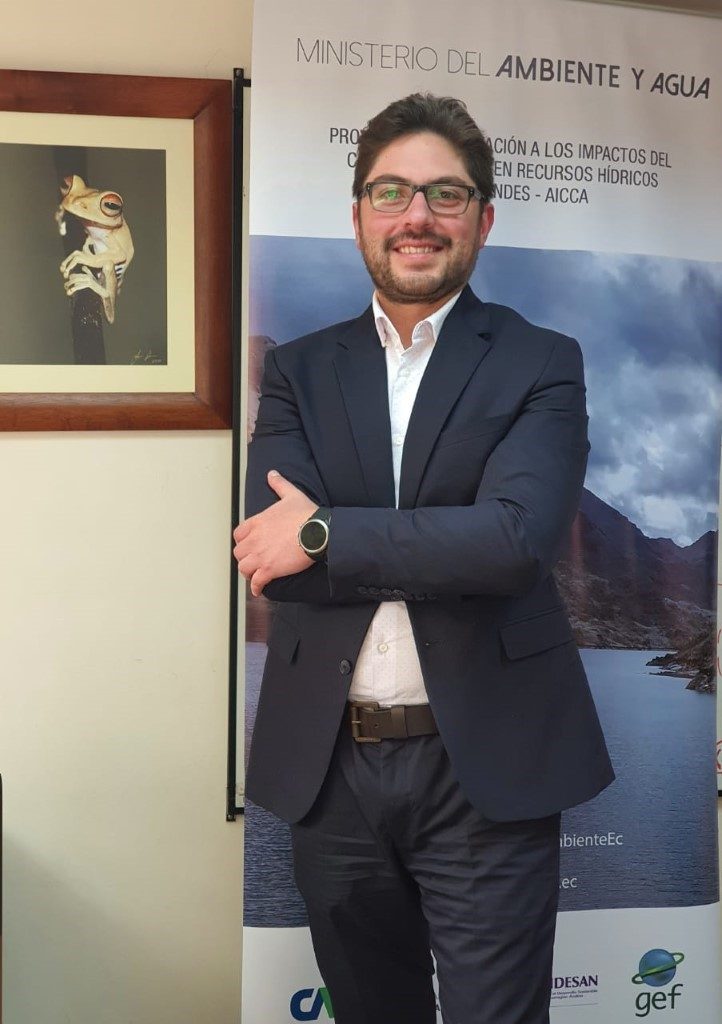Two special days were commemorated during September: September 7 – International Day of Clean Air for blue skies and September 16 – International Day for the Preservation of the Ozone Layer, which relate to the importance of caring for the air. The Undersecretary of Climate Change of the Ministry of Environment and Water was interviewed to learn how these issues are related to forest conservation.
- What policies does MAAE promote to improve air quality and mitigate GHG emissions in the atmosphere?
Ecuador has an Ambient Air Quality Standard or Immission Level, which establishes the maximum allowable concentrations of “criterion pollutants” (sedimentable particles, particulate matter less than 10 microns, particulate matter less than 2.5 microns, Sulfur dioxide, Carbon monoxide, Ozone, Nitrogen dioxide). The main objective of this Regulation is to protect people’s health, ambient air quality, the well-being of ecosystems and the environment in general; the standard establishes maximum permissible limits for pollutants in ambient air at ground level.
Regarding climate change issues, it is important to note that Book IV on Climate Change of the Regulations of the Organic Code of the Environment defines the legal and institutional framework for planning, articulating, coordinating and monitoring public policies aimed at designing, managing and executing climate change adaptation and mitigation actions at the local, regional and national level in a transverse, timely, effective, participatory, coordinated and articulated manner with the international instruments ratified by the State, and the principle of common but differentiated responsibility.
The National Environmental Authority, MAAE, has the National Climate Change Strategy (ENCC), a planning instrument for guiding climate change policy that is implemented in harmony with the Constitution, international instruments ratified by the State and the National Development Plan. Under this instrument, the National Climate Change Mitigation Plan is being developed with a long-term vision (2050) that seeks to achieve a transformational change towards sustainable development. It pursues decarbonization of the economy, proposes technological, socioeconomic and environmental changes in the private sector, and incorporates a gender and most vulnerable groups approach.
Finally, the Plan for Implementing the Contribution Determined at the National Level is being developed. It aims to implement policies, actions and efforts to reduce greenhouse gases, increase resilience and reduce vulnerability to the adverse effects of climate change in sectors prioritized in the National Climate Change Strategy for the 2020 to 2025 period.
- What is the importance of forests for maintaining clean air and preserving the Ozone Layer?
In 1979, a decrease in ozone concentration, known as a “Hole in the ozone layer,” was detected at the South Pole. Gases that cause ozone depletion, known as chlorofluorocarbons (CFCs), are composed of fluorine, chlorine and carbon, and are used in domestic and industrial refrigeration circuits, and as propellants for sprayers, aerosols and dry cleaning. Studies carried out by scientists over a large area of Antarctica showed that the hole in the ozone layer caused climatic change, which seriously affected tree growth in the southernmost regions of the world.
This decrease in the ozone layer strengthened polar vortex winds, affecting currents that descend to the lowest layer of the Earth’s atmosphere; this change in direction, in turn, affected the paths of storms and rains over South America, East Africa and Australia, which increased the risk of drought in those areas by displacing the rain away from coastal areas. This is the case in Argentina, where these phenomena led to a decline in growth rate of its forests.
The Ozone Layer, which currently acts as a protective shield in the Earth’s stratosphere, is known to be recovering. It should be mentioned that in 1987, with the signing of the Montreal Protocol, world leaders took measures that have now proven to be effective; it has been possible to reduce emissions of chemicals that were causing ozone loss, and prevent the hole from continuing to grow.
As we all know, without the ozone layer life on earth would be impossible. It absorbs most of the ultraviolet radiation that reaches us from the sun, and an increase would have negative effects on watersheds, agricultural lands and forests. Furthermore, it would cause more sunlight to impinge on humans, giving rise to diseases such as cancer, cataracts, immune system damage, and others.
It is essential to give greater importance to conserving and restoring forests and reforestation, and using them in a responsible and sustainable manner, since they are the largest carbon sinks in the world. It should be mentioned that forests not only provide environmental goods and services, but also absorb carbon dioxide from the atmosphere, trap it as they grow, and release it when they burn or rot. That is why forests are great natural reserves of greenhouse gases, and through photosynthesis they provide the planet with oxygen.
- What are the consequences of deforestation? And what is its impact on the atmosphere?
Deforestation is a historical process with several causes or triggers that activate it or cause it to behave differently in a given space-time. It involves the loss of natural forests due to anthropic activities, such as logging or burning large areas in order to utilize timber resources inappropriately, expand the agricultural frontier for new crop or livestock areas, or unplanned urbanism, and others.
The main impacts of deforestation on the atmosphere involve the climate. Since they are directly related, the more forest cover is lost, the more rainfall decreases, which implies less vegetation, loss of biodiversity, disturbance in the thermal balance, alteration of lifestyles of local populations, and impacts on the water cycle due to the decreased amount available for the population. Regions that suffer deforestation tend to have increased soil erosion and eventually it becomes non-productive land, leading to a shortage of products for rural communities, such as wood, food, fuel, fodder, fibers, organic fertilizer, and others.
Another consequence of deforestation is its direct impact on climate change, since greenhouse gases (GHG) are absorbed by forests; if natural forest areas are lost, the gases rise to the atmosphere and cause climatic disturbances, and the ecosystem loses functionality. It should also be noted that deforestation is directly related to other phenomena such as degradation and desertification, mainly the latter, since the main consequence of the lack of forest cover is the loss of soil fertility.
According to Ecuador’s REDD+ Action Plan “Forests for Good Living” (2016-2025), deforestation is the result of interactions between ecological, social, economic, and cultural factors at various levels. In Ecuador, according to the report on emissions due to deforestation for the 2014-2016 period, 38,183,462 tons of CO2 equivalent were emitted into the atmosphere and in the 2016-2018 period, 34,044,286 tons of CO2 equivalent were emitted into the atmosphere due to the deforestation.
- How does the Ministry of Environment and Water contribute through PROAmazonía to reducing deforestation in the Ecuadorian Amazon?
Ecuador’s REDD+ Action Plan sets out the national guidelines for efficient implementation of REDD+ measures and actions in Ecuador, which directly address the causes of deforestation and forest degradation due to local needs and development priorities.
In line with the REDD+ measures and actions established by the country, the Comprehensive Amazon Program for Forest Conservation and Sustainable Production – PROAmazonía is a program of the Ecuadorian Ministry of Environment and Water and the Ministry of Agriculture and Livestock, implemented with the support of the United Nations Development Program – UNDP. Its main objective is to reduce deforestation, and to achieve that, it contributes to the agendas and priority policies of the country’s economic sectors. It also promotes the sustainable and integrated management of natural resources, and contributes to the eradication of poverty and sustainable human development. PROAmazonía was the first program to implement the REDD+ approach in Ecuador at the national level.
PROAmazonía is financed with non-reimbursable funds from the Green Climate Fund (GCF) and the Global Environment Facility (GEF). It will work actively until 2023 to promote sustainable development in the Amazon through various activities such as strengthening territorial planning (PDOT) and life plans with a focus on conservation, sustainable production, climate change, gender and interculturality; it creates platforms and regional action plans for supply chains, strengthens associations, provides technical assistance, implements certification schemes and the traceability of sustainable, deforestation-free products; sustainable forest management and bio-enterprises; as well as ecosystem conservation and restoration.
- Ecuador was recognized by the international community for its efforts in reducing CO2 equivalent emissions through deforestation avoided during 2014. How important is this recognition? And how will it contribute to Forest conservation?
Ecuador is categorized internationally as one of the most advanced countries in REDD+ with a national focus. Once the three phases of REDD+ ended in 2018, the country began preparing a financing proposal for GCF, which was approved by the Board of Directors of that fund in 2019.
This recognition is very important, as it rewards the country (Government and key stakeholders) for the efforts made to reduce 3.6 million tCO2 equivalent (atmospheric emissions avoided), which was achieved through the government’s commitment to actions and environmental policies for promoting forest conservation and sustainable use of biodiversity.
The Ecuador REDD+ Results-Based Payments Project seeks to give continuity and complement actions previously promoted by other REDD+ initiatives that have been implemented in the country, such as the PROAmazonía program that began in 2018, and the REM program that began in 2019.
The following activities were implemented with these funds:
-
- Land use plans at the local level.
- Improved management of land rights in protective forests and national protected areas.
- Establishment of public-private partnerships to market deforestation-free products from the Amazon.
- Support for SMEs.
- Research and development on industrial uses of NTFPs (Non-timber forest products) and other deforestation-free products.
- Increased forest restoration efforts in coastal and highland areas of Ecuador.
- Strengthening of MAAE institutional capacity to manage the implementation of the REDD+ Action Plan.
- Improvement of National Forest Monitoring System capacity to monitor forest degradation.
- Implementation of a Plan for free, prior and informed consultation with interested parties and an environmental and social management plan for using the proceeds.
- Strengthening of REDD+ implementation in indigenous territories (CONFENIAE Plan for the implementation of REDD+ measures and actions).
The project will carry out activities for strengthening forest governance, developing sustainable productive alternatives and restoring forests.

 Español
Español English
English
